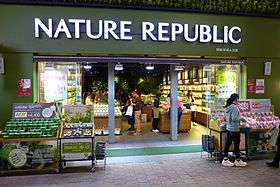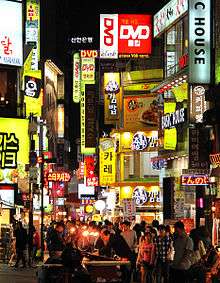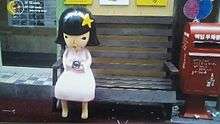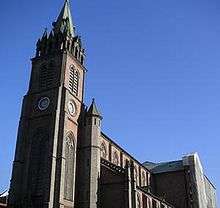Myeong-dong
| Myeongdong | |
|---|---|
| Korean transcription(s) | |
| • Hangul | 명동 |
| • Hanja | 明洞 |
| • Revised Romanization | Myeong-dong |
| • McCune–Reischauer | Myŏng-dong |
|
Myeongdong, Seoul | |
 | |
| Country | South Korea |
| Area | |
| • Total | 0.99 km2 (0.38 sq mi) |
| Population (2013) | |
| • Total | 3,320 |
| • Density | 3,400/km2 (8,700/sq mi) |
Myeongdong (Hangul: 명동; Hanja: 明洞, literally 'bright cave' or 'bright tunnel) is a dong in Jung-gu, Seoul, South Korea between Chungmu-ro, Eulji-ro, and Namdaemun-ro. It covers 0.99 km² with a population of 3,409 and is mostly a commercial area, being one of Seoul's main shopping and tourism districts.[1] In 2011, 2012 and 2013, Myeong-dong was listed as the ninth most expensive shopping street in the world.[2][3][4] The area is known for its two historically significant sites, namely the Myeongdong Cathedral and the Myeongdong Nanta Theatre.
History
Myeongdong dates back to the Joseon Dynasty when it was called Myeongryebang (Hangul: 명례방; Hanja: 明禮坊) and mostly a residential area. During the Japanese era the name was changed to Myeongchijeong (Hangul: 명치정; Hanja: 明治町, Meijicho in Japanese pronunciation) and became more of a commercial district, being influenced by the rising commerce in the neighboring Chungmuro area.[1] It became the official district of Myeongdong in 1946, after independence.[5]
After the Korean War and into the 1960s, the economy blossomed and the financial sector from Namdaemun-ro and Euljiro gradually expanded into Myeongdong. The area flourished as city renovations took place and highrise buildings were built. Many department stores, shopping centers, restaurants, upscale shops and boutiques set up their businesses in Myeongdong and it became the mecca for the young and trendy in the 1970s.[1]
Besides being a major commercial and financial district, Myeongdong has been a popular location for political demonstrations and protests, especially during the turbulent years of the 1980s and 1990s. Myeongdong Cathedral has been a frequent spot for many of these demonstrations and still is to this day.[5]
As of March 2000, Myeongdong's has been designated as a special Tourism Promotion Area and is one of the stops on the official Seoul City Bus tour's main route.[6]
Characteristic

Seoul's financial hub is divided between here and Yeouido where the Korea Stock Exchange is located. Major insurance, securities, financial services companies, and investment firms with headquarters in Myeongdong include Citibank, SK Corporation, Kookmin Bank, Korea Exchange Bank, Lone Star Funds, Sumitomo Mitsui Banking Corporation, AIG Korea Insurance, Hana Bank, and HSBC. The Bank of Korea is also in the vicinity.
Other notable landmarks in Myeongdong include the Chinese Embassy, which was first opened on January 4, 1949.[7] YWCA headquarters, UNESCO Hall, Myeongdong Theater, and the oldest Catholic cathedral in Korea, Myeongdong Cathedral.
Except for early morning and late night delivery hours, the main street and most of the alleys are blocked off for pedestrians to roam freely without being hindered by traffic.[8]
Shopping



Myeongdong is one of Seoul's main shopping districts featuring mid-to-high priced retail stores and international brand outlets, including Lacoste, Polo Ralph Lauren, Forever 21, Bulgari and Louis Vuitton, as well as Korean cosmetics brands such as Nature Republic, Missha, The Face Shop and Skin Food.[9] It is a particularly popular area for young people and tourists as a center for fashion and sight-seeing.[1] Several large shopping centers and department stores are in the district including Lotte Department Store, Shinsegae Department Store, Migliore, M Plaza, and Noon Square.
In August 2012, as part of Lotte Department Store's expansion programme into China, a replica of the street of Myeongdong is featured in its new store in Tianjin, with outlets of Missha, The Face Shop and Skin Food.[10]
The floating population of Myeongdong is estimated to be around 2 million a day[11] and in terms of floorspace rents, Myeongdong is one of the most expensive shopping districts in the world.[12] Many hotels, restaurants, cinemas, theaters, and historical sites complete the diverse mixture of the area. In a poll of nearly 2,000 foreign visitors, conducted by the Seoul Metropolitan Government in November 2011, stated that 13.4 percent named shopping in Myeongdong as their favorite activity in Seoul.[13]

Attractions
Myeongdong Festival has been hosted since 1982 to vitalize the commercial area and encourage tourism.[14] It is usually held twice a year: from the end of March to the middle of April in spring, and the month of September in autumn. Parades, music and dance performances, fashion shows and other spectacles are part of the festivities. Many shops and stores offer product sales and discounts during this time as well.
In 2012, the area hosted the street parade of the Cheonan World Dance Festival in October.[15]
- China Street[16]
Transportation
The southern part of Myeongdong is served by Station #424, Myeong-dong on ![]() Line 4 of the Seoul Subway, while the northern area is closer to
Line 4 of the Seoul Subway, while the northern area is closer to ![]() Station #202, Euljiro 1-ga on Line 2. Many inner and outer city bus lines pass through the district for easy access.
Station #202, Euljiro 1-ga on Line 2. Many inner and outer city bus lines pass through the district for easy access.
Education
International schools include:
See also

- Myeongdong Cathedral
- List of upscale shopping districts
- Economy of South Korea
- List of Korea-related topics
References
- 1 2 3 4 Jung-gu Office, Retrieved 2010-05-26 (Korean)
- ↑ "Myeong-dong Is World's 9th Most Expensive Shopping Street". Chosun Ilbo. 2 September 2011. Retrieved 9 April 2013.
- ↑ "Myeong-dong Store Rent 9th Highest in the World". Chosun Ilbo. 16 November 2012. Retrieved 9 April 2013.
- ↑ "Myeong-dong, world's 9th highest commercial rental prices". The Korea Herald. 14 November 2013. Retrieved 14 November 2013.
- 1 2 Myeongdong from Doosan Encyclopedia (Korean)
- ↑ Tourism Promotion Area Jung-gu Office (Korean)
- ↑ "South Korea-Taiwan relations 'in a rut'". Yonhap News. 2002-08-21. Retrieved 2008-02-05.
- ↑ "Myeongdong streets to become pedestrian friendly", Munhwa Ilbo 2008-03-03 (Korean)
- ↑ "Travel Highlights: What To Buy When Shopping in Korea". Korea Tourism Organization. Retrieved 8 October 2012.
- ↑ Kim, Jung-yoon (31 August 2012). "New dawn rising for Lotte in China". Joongang Daily. Retrieved 8 October 2012.
- ↑ C.K. Jang "Myeongdong commercial district" MK Business News 2010-05-12 (Korean)
- ↑ The world’s most expensive streets 2006 finfacts Retrieved 2008-02-23
- ↑ "Mt. Nam Tops List of Foreign Tourists' Favorites". Chosun Ilbo. 28 November 2011. Retrieved 23 April 2012.
- ↑ Myeongdong Festival, Jung-gu Office
- ↑ "Myeongdong to Host Dance Street Parade". Korea Tourism Organization. 20 September 2012. Retrieved 4 October 2012.
- ↑ "Seoul's 'China Street' Begins to Revive". Chosun Ilbo. 8 January 2008. Retrieved 28 November 2012.
- ↑ "SEOUL CHINESE PRIMARY SCHOOL." International School Information, Government of South Korea. Retrieved on March 30, 2016.
External links
| Wikimedia Commons has media related to Myeongdong. |
- Visit Korea
- Myeongdong Tourist Info (English)
- Life in Korea
- Myeongdong Tourist Zone (Korean)
- (Korean) Myeongdong resident office website
Coordinates: 37°33′49″N 126°59′02″E / 37.5637°N 126.9840°E